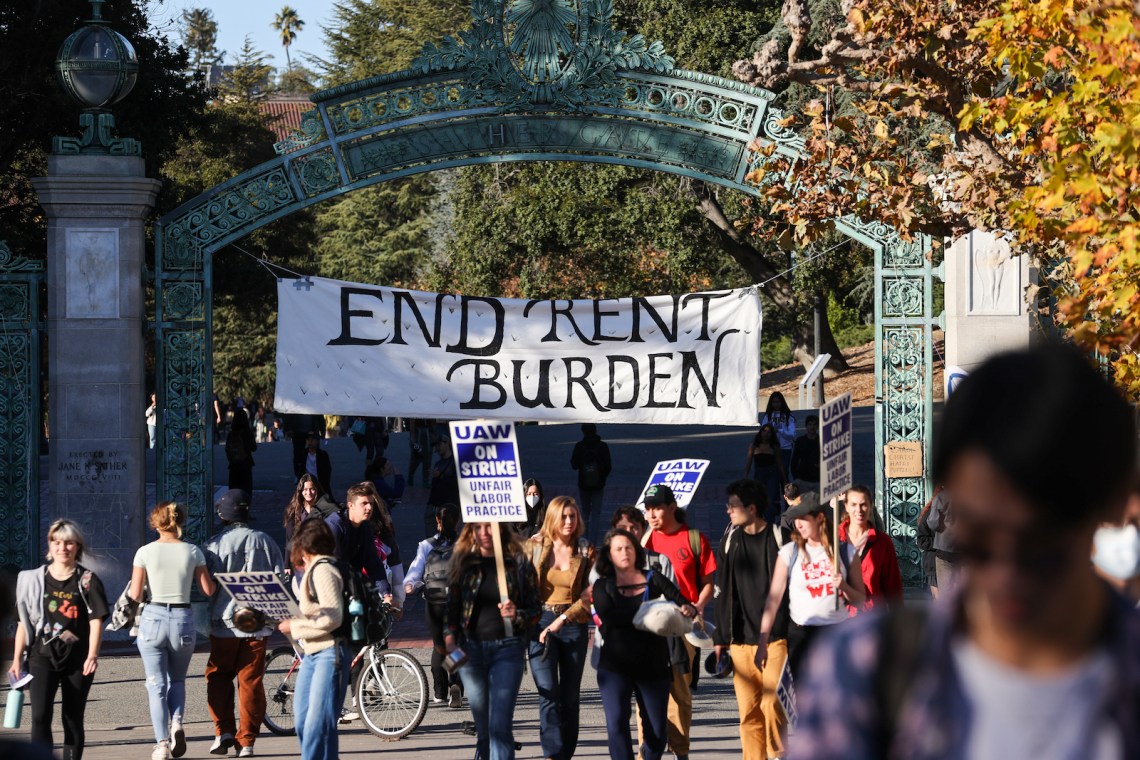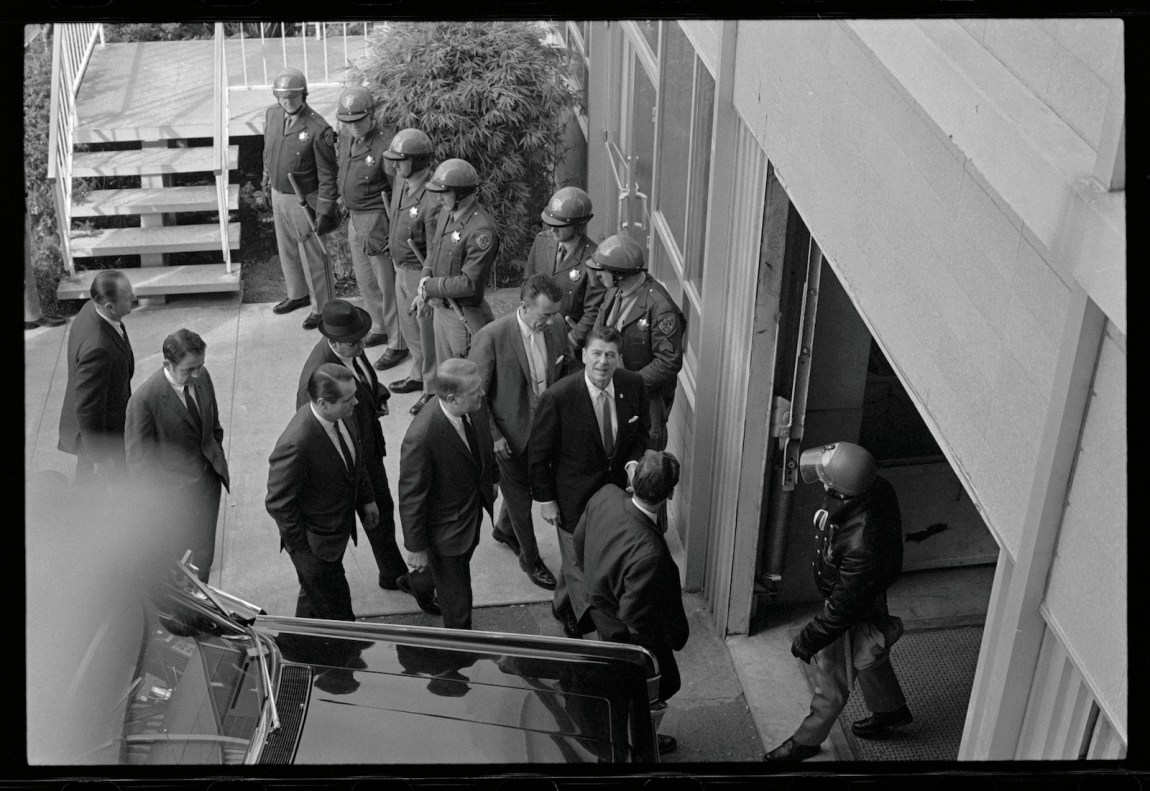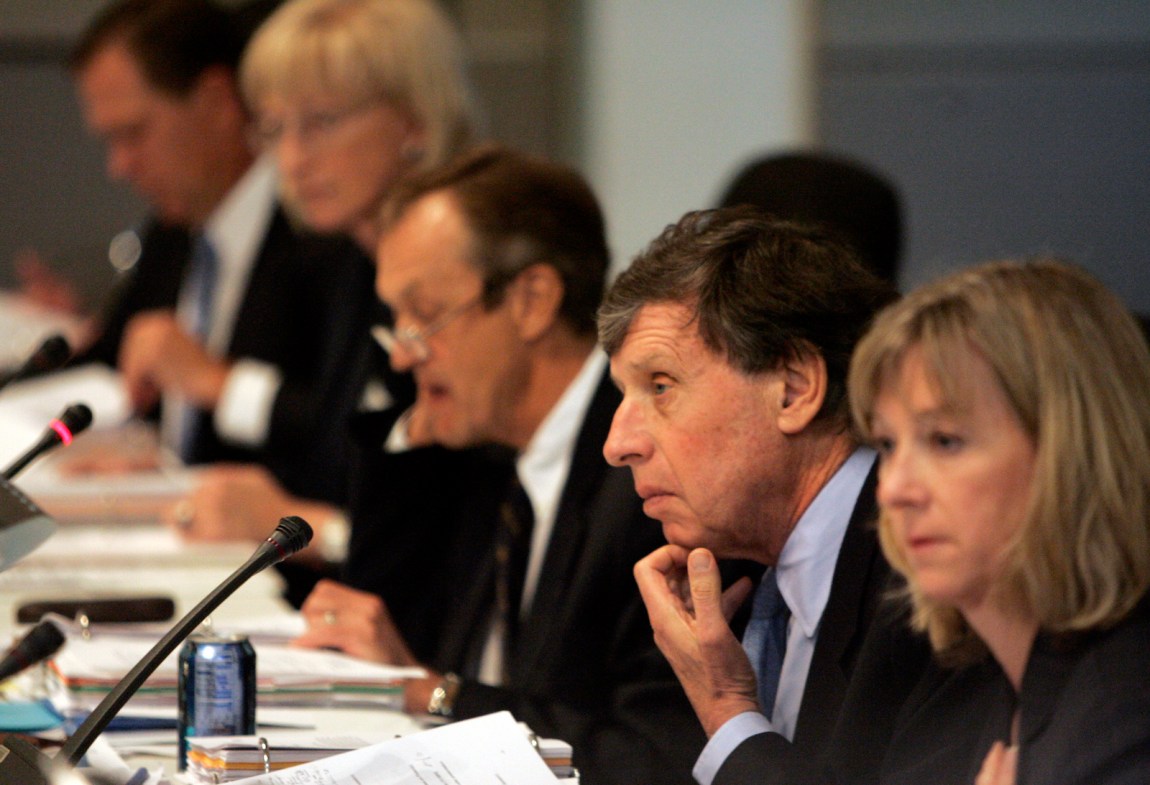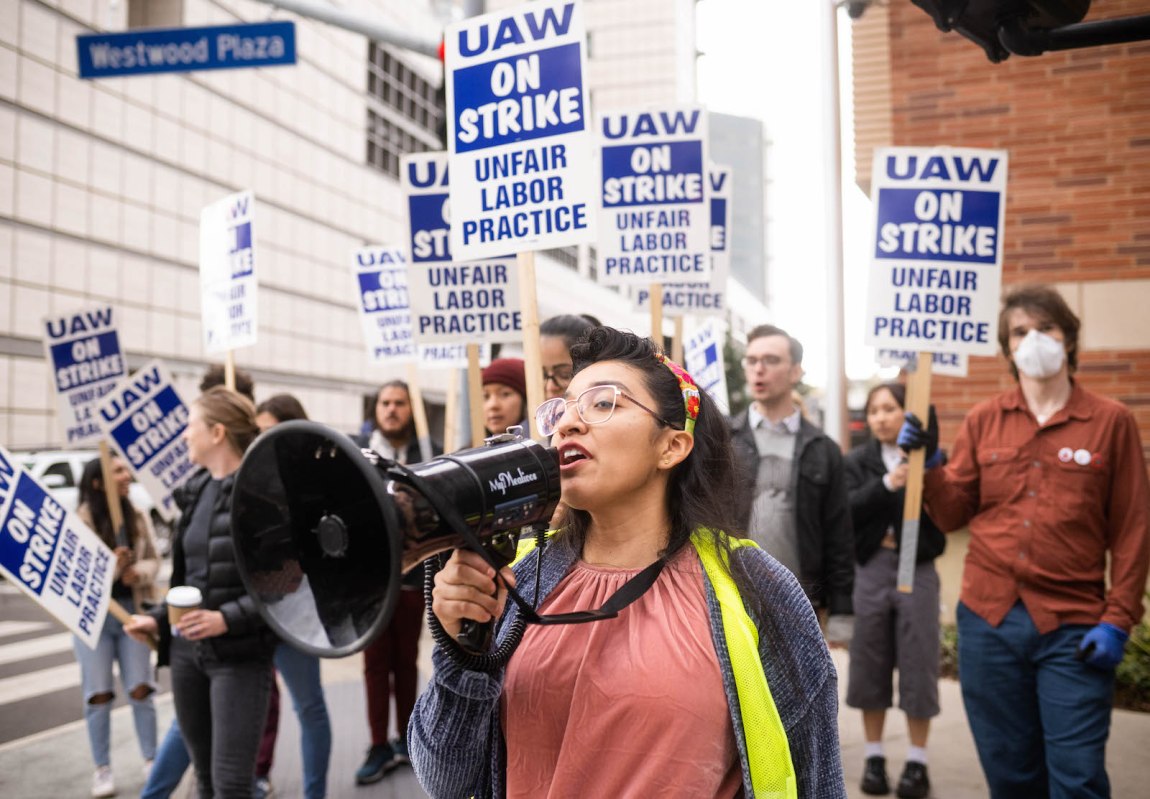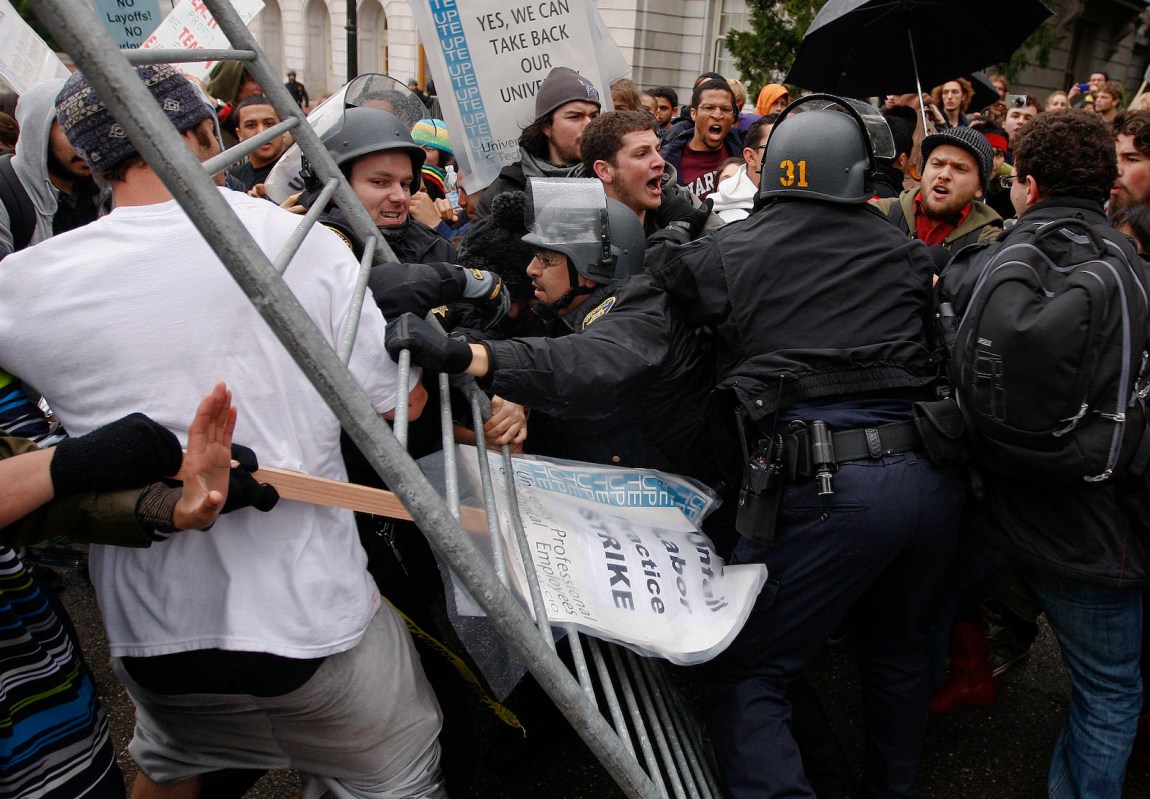Last year ended with a surge of organized labor actions on university campuses across the United States, from Rutgers and Northwestern to Yale and the University of Chicago. In November academic workers at the New School began a three-week strike, during which the administration announced on the university’s Twitter feed that it had “made the difficult decision to stop paying wages and premiums for healthcare benefits for employees who are striking.” In response, the historian Keeanga-Yamahtta Taylor wrote, “For any of you that thought the academy was some sacrosanct space to idle about & contemplate the meaning of life, pls wake the fuck up. It is a workplace with bosses and workers.” In the same month, 48,000 workers at the University of California—my workplace—started a strike that would, for most of them, last almost six weeks. It was the largest academic labor action in US history and the biggest strike of 2022 across all industries.
It ended on December 23, when members of the United Auto Workers (UAW), the union to which the UC’s doctoral and postdoctoral workers belong, voted to ratify a contract that includes higher wages and childcare subsidies, expanded healthcare coverage, family leave, transit benefits, and other improved terms of employment. For graduate and postdoctoral workers, who have long endured inadequate pay and benefits, this contract is overdue. But the UAW workers had initially made broader demands, including a cost-of-living adjustment that would link annual raises to median rents campus by campus and an initiative to defund, disarm, and disband the University of California Police Department (UCPD). To make those demands was to recognize that the UC system is not only an employer—the third largest in California, itself the planet’s fifth-largest economy—but also a major financial actor, real estate investor, and police force. In 2021 alone it issued nearly $3 billion in municipal bonds, and it currently manages $5 billion in real estate. It maintains the UCPD, which has statewide jurisdiction, in part to secure these expansive property holdings.
The UC is not the only university with such structural sprawl. As the urbanist Davarian Baldwin puts it in his recent book In the Shadow of the Ivory Tower, “Schools have become the dominant employers, real estate holders, health-care providers, and even policing agents in major cities across the country.”1 How did we get here? What explains the contemporary university’s position in labor markets, housing markets, and financial markets—and its reliance on police forces paid to defend that position? How did the nation’s largest and most prestigious universities—private and public—become financial and real estate behemoths, entangled with Blackstone and Goldman Sachs? And how might scrutinizing these entanglements clarify the UC strikers’ most capacious demands?
The beginning of an answer is that universities in the US have always been terrains of race and class struggle. Much of the endowment capital that universities now invest with private-equity firms originated in profits from the use of enslaved labor and colonial exploitation. The real estate and land holdings on which universities now depend originated in state-sanctioned and police-backed indigenous dispossession.
In recent decades those struggles have been reshaped by the financialization of the public university. As state tax revenue fell, public universities made up for diminished public funding by raising tuition and issuing municipal bonds, leaving both students and the schools themselves in debt. Today the UC system, like many other universities, relies in particular on “general revenue bonds” that are guaranteed by university assets (e.g., real estate) and future income (e.g., tuition). To meet their bond obligations and keep their credit scores high, universities must increase tuition, real estate acquisitions, and profits from auxiliary services and decrease the cost of labor. This is the university—employer, landlord, and financier, guarded at every turn and every picket line by a dedicated police force—that the strike’s initial, broad demands were meant to challenge.
*
In 1862 President Lincoln signed the Morrill Act, distributing 79,461 parcels of indigenous land to states across the country for the sake of establishing university endowments—nearly 11 million acres obtained by violence-backed treaty or outright seizure. As Robert Lee and Tristan Ahtone showed in a 2020 report for High Country News, this dispossession financed the University of California and other land-grant universities.2 Presented to each state as a gift of “free” and “public” land, it enabled the UC to build on the land it needed, tax-free, and quickly generate capital by selling off some of the rest. UC Berkeley was founded six years after the passage of the Morrill Act. In their influential introduction to abolitionist university studies, the scholars Abigail Boggs, Eli Meyerhoff, Nick Mitchell, and Zach Schwartz-Weinstein point out that the school soon “established a military science department,” following the Act’s requirement that schools include “military tactics” in their curricula.3
Drawn by the Homestead Act of 1862, which offered them 160-acre plots of indigenous land, more white settlers were moving to California as UC Berkeley was opening its doors. Federal troops and local police ensured that these white claims to property were honored, and their work was given scholarly legitimacy by the military science research being conducted just over the walls. Two years after its founding, Berkeley began admitting white women, the vast majority of whom enrolled to become teachers. (The opportunity to attend school also motivated more white women to move to California, an enticement that was crucial to the expansion of white settlement.) Many went on to teach in Indian schools, filled with indigenous children taken by force from their families and communities. The public university’s “public” has been shaped from the beginning by white supremacist exclusion.
Advertisement
The mid-twentieth-century university is often romanticized as a truly public institution, but it too was the site of ongoing struggles over both the “public” of public education and the shifting part universities play in the labor market. Since the Morrill Act, universities had largely been bastions of white, upper-class privilege, but the 1944 GI Bill provided grants to World War II veterans that covered tuition and fees at any school that would admit them. White veterans from working-class families poured into campuses across the country. The 1.2 million Black soldiers who fought in the war, in contrast, were welcomed back to a de jure segregated country. Those who sought to use their GI Bill education benefits were either denied admission outright based on their race or saw their applications languish while administrators and politicians debated collegiate desegregation. The Veterans Administration pushed Black soldiers into vocational training rather than colleges and universities, and of the Black veterans who did attend college using GI Bill funds, 95 percent went to segregated all-Black schools.4
At the same time, after factory floors were freed from the war’s no-strike pledges, strike actions in the US were at an all-time high. By steering returning soldiers into higher education, the GI Bill also had the effect of steering them out of this increasingly powerful labor movement. While the Taft-Hartley Act of 1947 “limited workers’ organizing power and protected management’s ability to thwart unions,” the sociologist of education Eleni Schirmer argues, “the GI Bill subsidized veterans’ tuition, charting their path to higher wages while keeping them a safe distance from erupting shop floors.” The government was incentivizing the individual pursuit of higher education, rather than the collective pursuit of union power, as the optimal path to white class mobility.
Decades of organizing brought about not only de jure desegregation but also Great Society programs such as Medicare, Medicaid, Head Start, and what would later become known as Pell Grants—money for those who could not afford college. Enrollment at public colleges and universities soared on the back of this legislation, “from five million in 1964 to nearly eleven million in 1975,” as the sociologist Charlie Eaton observes in his new book, Bankers in the Ivory Tower.5 Federal student loan programs were launched in this era as well, “primarily,” as Eaton puts it, “to help upper-middle-class students attend higher-tuition private colleges.” In the decades after the Higher Education Act of 1965, the federal government started to woo private lenders—including Sallie Mae, Bank of America, and Merrill Lynch—into the student loan market by guaranteeing their loans and paying interest for lower-income borrowers, making the business effectively risk-free to investors.
This decade of astronomical growth in college matriculation was also a decade of student activism: organizing by the Black Panthers and the Brown Berets, as well as free-speech, feminist, and antiwar uprisings, swept campuses across the country, especially at California’s system of public colleges and universities. In the late 1960s, when these uprisings started, the UC system was funded by taxpayer money and tuition-free, with nominal fees, for California residents. Governor Ronald Reagan responded to the unrest by proposing tuition as a method by which public universities could “get rid of undesirables.” “Those there to agitate and not to study might think twice before they pay tuition,” he said in 1967. “They might think twice how much they want to pay to carry a picket sign.” Just as Black and brown students were organizing their way into historically white colleges and universities, fighting to get their histories onto syllabi and people who looked like them hired as professors, they were told they would have to pay for it. If Reagan made tuition the price of dissent with one hand, with the other he called in the National Guard to violently quell student protests. A slogan of the California student movement makes the ongoing connection between policing and the weaponization of tuition explicit: “Behind every fee hike, a line of riot cops.”
Advertisement
In the 1970s public schools across the country, most of which had been tuition-free or charged nominal fees, began a long process of levying and raising tuition, forcing families who couldn’t pay to take out loans. This was part of a broader neoliberal turn toward the financialization of public goods, a racialized debt trap. Between the late 1970s and 1990s, wealthy individuals and corporations withdrew their taxes from the public provision of healthcare, housing, and education. These economies instead shifted dramatically toward speculative, household debt–driven business models. California and other states invested much of the remaining tax revenue in the expansion of jails and prisons. Labor union membership also came under direct and sustained attack. The number of anti-union consulting firms grew tenfold within a decade, and the Supreme Court issued a series of devastating opinions weakening collective labor power. As transnational supply chains sent factory work across oceans, high-wage, unionized jobs for people without a college degree evaporated and were replaced by low-wage service jobs.
During this period more and more working-class people—and working-class people of color in particular—tried to attend college as a path to upward mobility. But because there were no longer tuition-free public options and the predatory for-profit college industry was booming, they could only do so by going into debt. By 2017, Eaton notes, the US Department of Education had become “the largest commercial bank” in the United States. The total amount of outstanding student debt in this country now ranks second only to mortgage debt—a staggering $1.7 trillion, held disproportionately by Black and brown women.
For public systems of higher education, including the UC, these were the years Eaton calls “the squeeze.” Public universities suffered a catastrophic loss of state and federal funding, both due to the protracted withdrawal of tax revenue and because private student lenders and for-profit colleges were receiving federal subsidies at their expense. (“For-profit colleges,” Eaton writes, “captured 25 percent of all Pell Grant expenditures at their peak in 2011.”) The squeeze led university leaders directly into the arms of financiers. Universities came to rely on two debt-generated revenue streams: making families take out student debt from the federal government to pay tuition, and selling investors municipal bonds that burdened the schools with debts of their own.
*
Today UC tuition hovers around $14,000 annually for in-state residents (it is more than three times as much for out-of-state students), with total yearly costs—including fees, housing, healthcare, books, and supplies—nearing $40,000. Most people understand “public”—as in public school or public library—to mean tax-funded. Both my children attend public elementary school, and our taxes are redistributed to cover tuition for all students.6 The UC system is no longer public in this sense, just as it has never been public in the sense of “open to everyone.” As is increasingly true of nominally public institutions of higher education across the country, more of its core revenue comes from tuition—also known, for most families, as student debt—than from taxes. In the 2022–2023 fiscal year tuition is, at 53 percent, the largest source of UC’s “core fund” revenue, which pays for academic expenses like faculty and staff salaries, benefits, and student financial aid, as well as for academic infrastructure including equipment, supplies, and utilities. It is followed, at 43 percent, by money from the state of California.
Beyond core revenue, the UC budget also relies on proceeds from medical centers, government grants and contracts, donor support, and a category the university refers to as auxiliary: revenue from housing, dining, bookstores, athletics, parking, cultural institutions, and events. With state funding unpredictable and often in short supply, formerly public universities have turned to these auxiliary amenities both to generate their own revenue and to justify higher tuition and fees. But how do you fund the construction of state-of-the-art dorms and dining halls, stadiums, and museums? You go to the capital markets.
By the turn of the twenty-first century California, along with much of the country, was operating under budget austerity. In 2003 the state cut 8 percent of its appropriations to the UC system, a crisis to which the UC regent and billionaire private equity investor Richard Blum responded with new financial strategies. Among them, Eaton writes, was issuing bonds guaranteed not by tax revenue but by real estate assets and future tuition. As Blum put it in an oral history interview Eaton cites, “I brought the guys in from Lehman Brothers who knew the university. They said, ‘No, your debt capacity is not a billion dollars. If you’re willing to go down to A credit, it’s probably eleven billion dollars.’”
Two decades later UC’s most recent statement available via Electronic Municipal Market Access (EMMA) reveals that today’s revenue bonds outstanding—debt the university owes—come to $27,564,105,000, with plans to issue over $1 billion more in the coming year. Goldman Sachs and Morgan Stanley represent both the UC Regents and the banks underwriting the bonds, and rake in handsome fees for doing so. More than half of these bonds are backed “by a pledge of general revenues,” including “gross student tuition and fees,” “facilities and administrative cost recovery from contracts and grants,” and “net sales and service revenues from educational and auxiliary enterprise activities.” In other words, the university has pledged tuition revenue, profits generated from housing and real estate, dining, sports stadiums, parking fees, and more to pay off its debts.
In addition to revenue bonds, the EMMA document details billions in commercial paper, bank loans and credit agreements, and bonds issued by the California Infrastructure and Economic Development Bank and the state’s community development and municipal finance authorities. Total debt outstanding at the end of 2021 was $30.2 billion. In 2021–2022, the UC system spent nearly as much annually on interest alone on these debts as it did on scholarships and fellowships or retiree health benefits.
One way to look at all this debt is as bondholder power, or leverage, over the university. The UC’s growing dependence on bond revenue changes what the university is, what it does, what it means. To repay outstanding bonds and attract future investment, the UC must keep prioritizing revenue-generating projects, including for-profit real estate ventures; maintain a docile and precarious (i.e., untenured) labor force; and promise that tuition will keep rising—or at least that higher-paying out-of-state and international student enrollment will increase. Universities’ contractual obligation to prioritize repayment to creditors means that “only after money has been set aside for the banks,” in Schirmer’s words, “does a university begin to pay its workers, distribute financial aid to students, or grant sick time and health insurance to employees.” Once it was tax dollars from the wealthy that funded public universities. Today it is their tax-shielded capital, on which they are earning interest. As the historian Destin Jenkins puts it, municipal bonds are “a redistributionary claim of a few on the many,” and universities have become yet another investment vehicle for the rich.7
*
Rating agencies codify and formalize bondholder power. In 2021 Moody’s Investors Service released an updated Higher Education Methodology explaining how it rates higher education bond issuers. Moody’s distinguishes between educational institutions in the public and private sector. Government oversight at public colleges and universities, it notes, lets them “operate with somewhat weaker financial performance and metrics than their private sector counterparts,” lowering their score. If, as is often said, Harvard is a hedge fund with a university attached, Eaton shows that part of what has made it so are investments brokered within elite social networks, away from the oversight of regulators.8 The secrecy and proprietary information those networks afford add value to financial deals by keeping regulators and competitors at bay. In contrast, the government scrutiny and transparency to which public institutional finances are subjected leave financial deals at schools like the UC open to competition, regulation, and public outcries.
The Higher Education Methodology goes on to explain that a university’s credit score may be negatively affected by “social risks.” For Moody’s, these include reduced student enrollment and government limits on tuition growth at nominally public institutions, since to secure top credit ratings universities must prove that tuition can always go up (yielding enough revenue to pay off debts). And yet, seemingly without irony, Moody’s also considers rising student debt—the outcome of ever-rising tuition—to be a social risk, as mounting attention to the $1.7 trillion elephant in the room calls “the value proposition of higher education” into question. Finally, Moody’s considers anything that might “limit the ability of colleges and universities to reduce staff” (such as unions, a fair contract, or tenure) additional risk burdens.
Bondholder power is also evident in how the UC presents itself to potential investors. In Appendix A of the EMMA document, the university promises labor docility—or more pointedly, no rise in salaries significant enough to threaten its ability to service debt. “It is always difficult to determine with assurance the future course of employer-employee relations,” the document reads. “Nevertheless, at the current time, The Regents does not anticipate that the future labor relations climate within the University will have a material adverse impact upon the ability of The Regents to pay the principal of, premium, if any, and interest on the 2022/2023 Bonds when due.”
Moody’s also makes clear that whereas government oversight, tuition limits, unions, and tenured jobs can harm an issuer’s credit score, owning marketable real estate can improve it. Real estate that is not central to the institution’s educational mission (what Moody’s calls “partible”) is particularly valuable, because in theory such real estate can be sold easily and thus serve as more liquid collateral on debt. But “essential” real estate is valuable, too, insofar as it can generate revenue and add value to the UC’s entire asset portfolio. Appendix B reassures investors that the UC’s “capital assets have increased due to continued investments in facilities in excess of depreciation” and that “the largest capital asset additions in 2021 were related to the construction of housing facilities at various campuses.”
In short, real estate is central to the financialization of the UC system, as it has been to the university ever since the Morrill Act. The UC is by some accounts the largest landlord in the state, managing 150,000 tenants in both on-campus and off-campus housing. Just days after the 2022 strike concluded, the Financial Times reported that the UC system had invested $4 billion in endowment funds with Blackstone’s private real estate income trust (BREIT), with a guaranteed annual return on investment (ROI) of 11.25 percent. The economist Daniela Gabor has estimated that to meet this extraordinary ROI obligation, Blackstone—a major private equity firm and the planet’s largest institutional landlord—will have to increase rents on properties held in the REIT by 12 percent annually.
These exorbitant rent increases have long been part of Blackstone’s housing business model, which relies on crises like the 2008 recession or the Covid-19 pandemic to produce distressed housing. Blackstone has a history of buying that housing in large portfolios, concentrating supply in their hands, evicting long-term tenants, raising rents precipitously, and bankrolling opposition to tenant protections like rent control. A $4 billion piece of the UC’s current financial model, in other words, is to exacerbate and profit from the housing affordability crisis faced not only by UC students and tenants across California but also in real estate markets across this country and in Europe, where Blackstone has aggressively purchased distressed housing in times of crisis.
The UC’s deal with Blackstone confirms how correct the striking UC workers had been to include a cost-of-living adjustment, or COLA, in their initial demands. The UC has campuses in some of the most expensive real estate markets in the country—San Francisco, Berkeley, Santa Cruz, Los Angeles, Santa Barbara—and its students and workers have long dealt with crushing rent burdens. Alex Ferrer, a doctoral student in geography at UCLA, used census data to map apartments affordable on a grad worker salary and found only 952 vacant apartments within ten miles of UCLA’s campus. “There are over 14,000 of us who work and study at UCLA,” he wrote, “and many more people who are not grad students who also need those cheap units.”
The UC system came out hard against the COLA demand, which the executive director of systemwide labor relations reportedly described as a dangerous subsidy to private landlords who own property near UC campuses. It was an utterly hypocritical statement, coming from an administration that was simultaneously inking a $4 billion deal with a private equity firm that the United Nations has accused of contributing to the global housing crisis. Far from being at the mercy of the housing market, the UC is by any measure a real estate market maker. The UAW bargaining team dropped the COLA demand by a 10–9 vote early in the strike, but tying wages to rent is a clear horizon for future organizing. Approaching the UC not only as a labor union but as a tenants’ union could be a significant source of leverage not only for UC workers but also for renters across California.
*
Every strike pickets on the strikes and collective actions that preceded it. As the University of California relentlessly raised tuition during the 2000s, students, staff, faculty, and other workers stepped up their resistance. That organizing reached a high point in 2011 when, in concert with the Occupy movement, protests erupted on campuses across the state. Participants were met with grim displays of police power and violence: in 2011 UCPD officers pepper-sprayed seated UC Davis students in the eyes; lines of riot cops greeted protesters at practically every Regents meeting. During and after these protests, organizers built strong ties between labor unions, students, and activist organizations. As Eaton meticulously chronicles, in 2012 this coalition won the passage of Proposition 30, establishing “California’s highest state income tax rate on millionaires since 1942.” A portion of these increased tax proceeds helped effectively freeze in-state tuition for the following decade.
But Proposition 30 did not fundamentally change the UC’s long-term business model. In 2020 graduate student workers across the UC system led a COLA strike unsanctioned by the UAW. They too were met with militarized violence, including by the California National Guard. The UCPD used an FBI surveillance portal to monitor participants’ whereabouts and social media accounts. UC Santa Cruz alone spent $300,000 per day on riot police. That wildcat strike’s demands—wages tied to rent and cops off campus—dissipated into the Covid-19 pandemic but resurfaced in UAW’s initial, more expansive demands last year.9
In the immediate aftermath of the latest strike, faculty at UCLA have been told that the increased cost of labor will be pushed onto the already austere budgets of departments and research centers. Faculty and students alike have also learned that they can expect attestation forms requiring them to report how much labor they withheld during the strike and thus how much of their pay will be subject to retroactive cuts. Victories—Proposition 30, putting a cost-of-living adjustment squarely on the list of demands, a new contract—are never the end of a struggle. As the geographer and longtime organizer Ruth Wilson Gilmore puts it, we need to organize for the day after victory.
The university reflects our current political-economic moment: the stunning debt of those who move through it, the paltry wages and insecure contracts of too many of the workers who run it, the inability of most people who work there to live anywhere near it, and the police who encircle its nervous, ever-expanding borders. It is no accident that many glimmers of union organizing now are on college campuses and in other sectors of the economy directly transformed by the shift from unionized blue-collar work toward low-wage service work, household debt, and soaring housing costs: Starbucks, Amazon, debtors’ unions, and tenants’ unions.10 Tracy Rosenthal has pointed out that “the first cost-of-living adjustment clause in a labor contract was made to quell another historic UAW action, the 1945 strike of General Motors,” in which “320,000 workers struck for 113 days, demanding wages high enough to be able to afford the cars they made.” Now UAW is often known in California as United Academic Workers, by far the largest contingent of workers it represents in the state.
Today’s organizers face a paradox. On the one hand, universities are more sprawling, hydra-headed, and powerful than they have ever been. On the other hand, that power makes them increasingly vulnerable to a wider range of transformative strategies—not only the collective power of workers to withhold their labor by striking but also the collective power of debtors, from tenants who owe their landlords to student debtors to medical debtors, to withhold their payments. The fact that UAW belongs to California’s Housing Now! coalition suggests that—despite its eventual vote against COLA—the union understands the potential of organizing its members as tenants in addition to workers. The statewide rank and file caucus, meanwhile, continues to reimagine what the university could be. To make a truly reparative public university for the first time, battles for fair wages and more tax revenue at the state level are both crucial and not nearly enough. The debtors, tenants, abolitionists, and workers of the UC system are often the same people, and it will be their organizing that will unsettle the university struggle by struggle.


